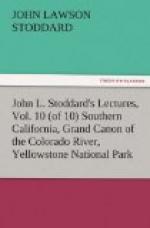Nor are these cliffs less wonderful in form than color. The substance of their tinted rocks is delicate. The rain has, therefore, plowed their faces with a million furrows. The wind has carved them like a sculptor’s chisel. The lightning’s bolts have splintered them, until, mile after mile, they rise in a bewildering variety of architectural forms. Old castles frown above the maddened stream, a thousand times more grand than any ruins on the Rhine. Their towers are five hundred feet in height. Turrets and battlements, portcullises and draw-bridges, rise from the deep ravine, sublime and inaccessible; yet they are still a thousand feet below us! What would be the effect could we survey them from the stream itself, within the gloomy crevice of the canon? Only their size convinces us that they are works of Nature, not of Art. Upon their spires we see a score of eagles’ nests. The splendid birds leave these at times, and swoop down toward the stream; not in one mighty plunge, but gracefully, in slow, majestic curves, lower and lower, till we can follow them only through a field-glass, as they alight on trees which look to us like shrubs.
[Illustration: TEMPLES SCULPTURED BY THE DEITY.]
But many of these forms are grander than any castles. In one place is an amphitheatre. Within its curving arms a hundred thousand people could be seated. Its foreground is the emerald river; its drop-curtain the radiant canon wall. Cathedrals, too, are here, with spires twice as high as those which soar above the minster of Cologne. Fantastic gargoyles stretch out from the parapets. A hundred flying buttresses connect them with the mountain side. From any one of them as many shafts shoot heavenward as statues rise from the Duomo of Milan; and each of these great canon shrines, instead of stained glass windows, has walls, roof, dome, and pinnacles, one mass of variegated color. The awful grandeur of these temples, sculptured by the Deity, is overpowering. We feel that we must worship here. It is a place where the Finite prays, the Infinite hears, and Immensity looks on.
[Illustration: THE CANON FROM ARTIST POINT.]
Two visions of this world stand out within my memory which, though entirely different, I can place side by side in equal rank. They are the Himalayas of India, and the Grand Canon of the Yellowstone. On neither of them is there any sign of human life. No voice disturbs their solemn stillness. The only sound upon earth’s loftiest mountains is the thunder of the avalanche. The only voice within this canon is the roar of its magnificent cascade. It is well that man must halt upon the borders of this awful chasm. It is no place for man. The Infinite allows him to stand trembling on the brink, look down, and listen spellbound to the anthem of its mighty cataract; but beyond this he may not, cannot go. It is as if Almighty God had kept for His own use one part of His creation, that man might merely gaze upon it, worship, and retire.




